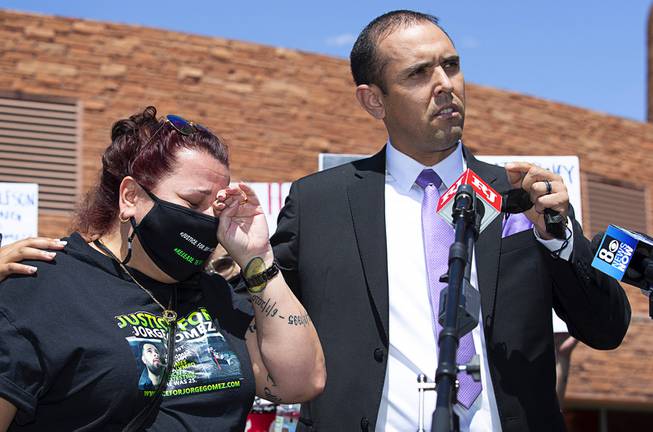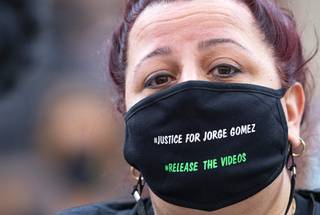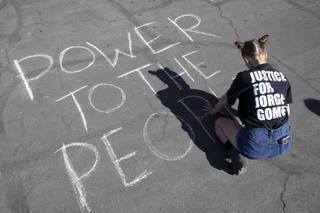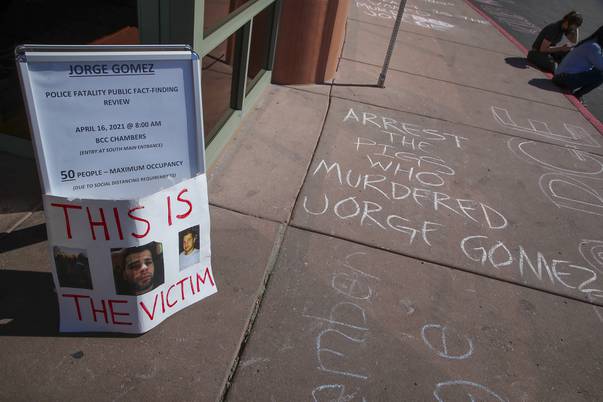
Jeanne Llera, left, mother of Jorge Gomez, wipes away a tear as family attorney Rodolfo Gonzalez speaks to reporters following a Police Fatality Public Fact-Finding Review at the Clark County Government Center Friday, April 16, 2021. Gomez was shot and killed by Las Vegas Metro police officers during a Black Lives Matter protest in downtown Las Vegas on June 1, 2020.
Friday, April 16, 2021 | 6:20 p.m.
Having just faced off with a crowd of rowdy racial justice demonstrators in downtown Las Vegas, Metro Police officers were already in a “heightened” state of alert.
Then, they received a call that one of their own was shot in the head about 3 miles south on Las Vegas Boulevard. With an unknown shooter roaming free, a cavalry of Metro squad cars fled south on Las Vegas Boulevard.
The red, blue and yellow strobe lights distorted the view of at least one camera that captured Jorge Gomez walking in front of the Lloyd George Federal Courthouse. Gomez was openly carrying two long guns and wearing body armor.
Officer Shay Mikalonis, who was shot and paralyzed on the Strip moments earlier as he was trying to break up another group of protesters, wasn’t the only person shot that night in the resort corridor during Black Lives Matter protests on June 1.
Related content
A couple of minutes later, eight of 19 rounds fired by four officers pierced the 25-year-old Gomez, who was running away after an officer shot him with less-than-lethal bean bags outside the courthouse.
Police allege he pointed a gun at them; his family contends that he was just running to safety.
A probe determined that there was no conclusive video evidence that Gomez pointed his rifle or pulled the trigger, Metro said in a contentious Police Fatality Public Fact-finding Review Friday at the Clark County Commission chambers.
If vivid footage of the shooting exists, Metro doesn’t have it, said Detective Jason Leavitt, the lead investigator of the Force Investigation Team, which compiled a report he highlighted during the nearly four-hour presentation.
The public proceeding comes after a preliminary finding by Clark County District Attorney Steve Wolfson that the officers who shot Gomez will not face criminal prosecution.
A federal civil lawsuit against the police agency is pending.
Key findings
Gomez first garnered police attention at the protest — but before the shooting.
At separate times, a sergeant with Metro and another with North Las Vegas Police had called for his arrest near Fremont Street and Las Vegas Boulevard for allegedly instigating officers, not dispersing when the protest was called unlawful, and touching his holstered gun and getting in a “shooting stance,” Leavitt said.
“Grab the gun guy” if you have an opportunity, the unidentified Metro supervisor said at 11:06 p.m., 16 minutes before Gomez was gunned down.
Statements attributed to Gomez’s father, Jorge Gomez Sr., after the Clark County Coroner’s Office called to inform him of the death led investigators to believe there was a conspiracy possibly connecting him to the Mikalonis shooting.
Leavitt noted the medical examiner relayed to police that the elder Gomez said his son was “radicalized” by the Black Lives Matter movement. He allegedly went on to tell a Metro sergeant in a phone call that he blamed Black Lives Matter for the death, and that the social justice movement had recruited and paid him.
The June 1 protest in Las Vegas was one of a series of demonstrations decrying George Floyd’s death under the knee of a Minneapolis police officer.
In a short interview Friday, Gomez Sr. contended that he didn’t say that, though he doesn’t recall what he actually said. “When somebody tells you on the phone … ‘Hey, we just murdered your son,’ I went blank.”
Neither conversation was recorded, Leavitt said, adding that the shootings were unrelated and there was no conspiracy involved. Officials have said the suspect in Mikalonis’ shooting, which occurred as he was breaking up protesters on the street, wasn’t part of the demonstration. Edgar Samaniego is suspected of shooting Mikalonis, who is paralyzed from the neck down, from a nearby motel.
Gomez was struck eight times
The four officers who opened fire on Gomez were on the way to respond to Mikalonis’ shooting but had stopped to put on protective gear when they encountered Gomez running. They are Sgt. Ryan Fryman, Vernon Ferguson, Daniel Emerton and Andrew Locher.
As Gomez was walking by the courthouse after most protesters had dispersed, he started to “shuffle” slowly, and placed his backpack in front of him. Detective John Squeo initially confused Gomez’s long gun with a baseball bat.
“Metro Police! Stay on the other side of the barrier,” Squeo told Gomez, referencing bollards at the courthouse.
“What barriers,” Gomez allegedly responded.
When a second officer ran down the stairs to arrest Gomez, Squeo began firing bean bag rounds.
Gomez ran, fell, dropped the rifle slung on his shoulder, got up, ran, and was gunned down seconds later. Between 15 to 30 seconds elapsed from the time Squeo opened fire, and the officers shot the live rounds.
Gomez was struck eight times — one time each in his head; on his nose; in his back; left flank; left hip; right side; left hand and left thigh, Leavitt said. The autopsy summary doesn’t specify how many rounds hit him from the back, but Leavitt said it was multiple.
Diagrams presented by Leavitt show the angles — between 72 feet and 95 feet across the street from where the officers shot from. Neither officer started shooting with Gomez’s back to them, according to the diagram, although two officers kept firing after Gomez had passed their line of sight.
Eleven of 19 bullets struck a cement wall, according to Metro photos, and pictures of Gomez’s plated vest showed 10 impacts on the front and sides and three on the back. Gomez didn’t fire a round.
The four officers provided a walk-through to the department’s Force Investigation Team to informally reenact the incident, placing markers where bullet shells were found and brown bags to indicate where officers stood when they opened fire. But the reenactment wasn’t recorded and they also declined to provide voluntary statements, which is common practice for union officers.
Gomez’s guns
Gomez was open-carrying — which is legal in Nevada — two Glock pistols in conversion kits that made them rifles. Police found a third Glock handgun concealed in his backpack.
The three guns had full magazines, and one showed that the trigger was pulled at one point, though the chamber was empty. Leavitt said it’s impossible to know when that trigger was pulled, and it could’ve been at any time and not necessarily during his interactions with police.
Had he survived, Gomez would’ve faced four counts of assault with a deadly weapon; one count each of possession of a short-barrel rifle, and carrying a concealed weapon without a permit, said Leavitt, to scoffs from Gomez’s family in the audience.
Family reaction
“What we saw was a circus, a pre-scripted hearing,” said attorney Rodolfo Gonzalez, who is representing Gomez’s family in the civil lawsuit against Metro, the four officers who killed Gomez, and the officer who fired the low-lethal rounds, who they allege triggered the deadly chain of events.
“What this did to the family was cause them more pain than anything else,” the attorney said in a press conference after the presentation.
Family and supporters took umbrage with the way Metro has vilified Gomez, they said. The presentation, for example, at one point showed footage of violent protesters, which didn’t include Gomez, and social media and text communications from Gomez before the shooting, which they said had nothing to do with his death.
They also had an issue on how the fact-finding review was conducted. A District Attorney’s Office representative and an ombudsman asked questions of Leavitt. But the ombudsman, attorney Josh Tomsheck, wasn’t representing the family.
Through ordinance, the fact-finding review is triggered when prosecutors express that they’re not pursuing charges.
“These officers, what they want to do, is tell you what happened not for you to believe with your own eyes,” said Jeanne Llera, Gomez’s mother, noting Tomsheck’s previous ties to the District Attorney’s Office as a criminal prosecutor. “Where is this fair? The whole situation is just unfair,” she said. “It’s a dog and pony show.”



